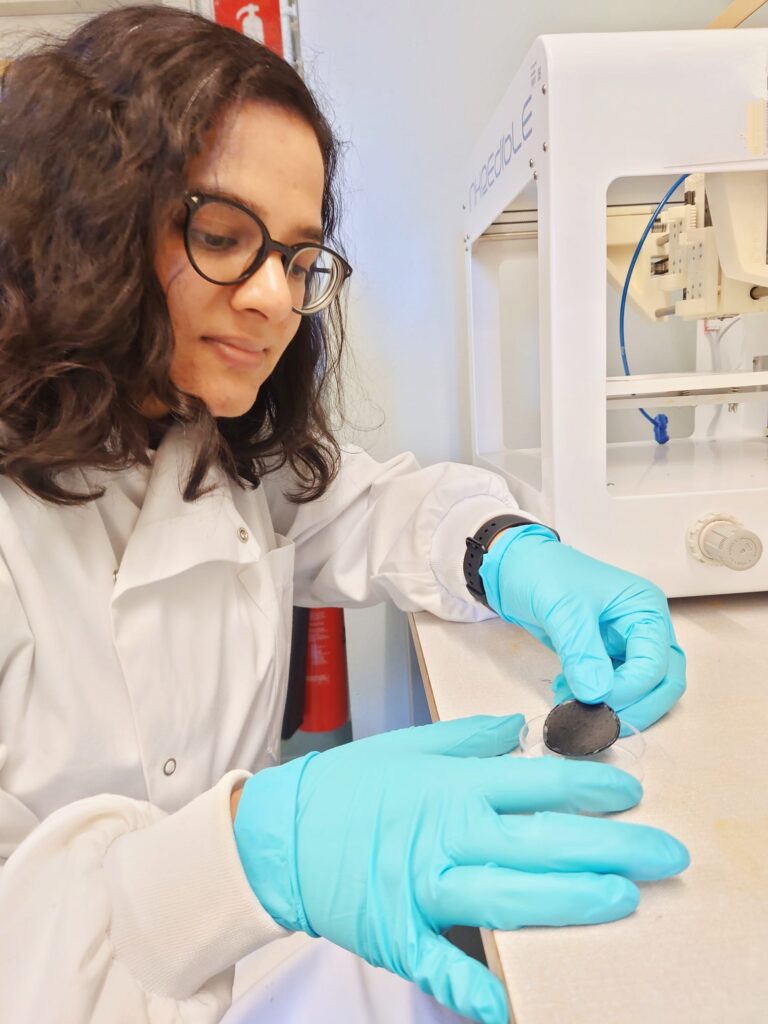Future healthtech wearables made of digital cellulose
The research within the Digital Cellulose Center is conducted by academic and industry partners, as well as Ph.D. students. The doctorates affiliated with the center lead many of the research projects to further generate new knowledge within the field of digital cellulose. Karishma Jain is one of the Ph.D. students within the center and guest blogger for this post.
Karishma’s research supports the Digital Cellulose Center’s focus area in developing digital devices with cellulose. Her project aims to answer what happens at the molecular scale when cellulose is mixed with electrically conducting materials. The results show promise for large-scale additive manufacturing of wearable health monitoring devices. The fabricated supercapacitor devices reach the theoretical limit of specific capacitance for PEDOT:PSS i.e. ~211 F/g. It also contributes to a digital circular economy with less electronic waste (e-waste) due to the presence of new cellulose-based electronics.
Cellulose-based devices for health monitoring

I have always been fascinated by nanotechnology and how small things can make such a huge impact on the world around us. This combined well with my interest in using science for environmental preservation and led me into the field of nanotechnology and cellulose-based composites. The Digital Cellulose Center’s doctorate position was a natural progression for me to further my knowledge of electronic devices made of forest materials.
Prior to joining the Digital Cellulose Center, I was working with paper-based sensors for health monitoring, which is a possible application area for my doctorate dissertation. My research aims to tailor the properties of cellulose to improve the electrical performance of composites, in order to use them in bioelectronics or energy storage applications. But let us start at the beginning.
I am researching how cellulose from trees and organic conductive materials interact with each other in order to turn cellulose into an electrical conductor. That means studying, at the molecular level, how cellulose molecules interact with electric conductors, such as conducting polymers.
A challenge when making cellulose electrically conductive is to make a “recipe” with the right mixture of “ingredients” and using the right amount, but also modifying them. The first part of my research shows that the mixture of cellulose and the conductive polymer PEDOT:PSS are highly affected by different factors such as pH, salt, and metal ions. It is important for two reasons. One, conductive polymers change the molecular structure and can be undoped or doped using various metal ions. Second, cellulose nanofibrils also interact strongly with metal ions hence, these ions can change the interaction between conducting polymer and cellulose. (K. Jain et. al, 2021, Journal of colloid and interface science.)
The research further shows how to modify the solution parameters to get more of the PEDOT:PSS particles on the surface of the cellulose, in order to increase the electrical conductivity in a composite. When the cellulose is chemically modified, we can also increase the interaction between PEDOT:PSS and cellulose. This led to an unexpected, but exciting finding – the modified cellulose only requires a small amount of the conductive polymer to increase the conductivity. Since conductive polymers are expensive, this modified solution opens up new possibilities for the industry to produce cost-efficient electronic devices made from forest materials.
Digital cellulose shows promise for large-scale printing of wearables
The preliminary results of the conductive properties are very promising. Our fabricated supercapacitor devices reach the theoretical limit of specific capacitance for PEDOT:PSS i.e. ~211 F/g. The research is especially pertinent to companies that develop wearable health monitoring devices as well as printed electronics. I am currently processing the composites into conductive inks which can be used for large-scale printing of conductive devices. The different cellulose-based inks can for instance be used in screen printing. This means that companies will be able to use this process to print electronic wearable devices on a large scale with conventional printing methods. My hope is that my research can serve as a guide for the industry in how to modify cellulose to make effective conducting composites and inks.

Since Europe is converting to a Green Economy, the role of forest-based products and the Digital Cellulose Center’s research is becoming even more prominent. I am excited about the possibility of making bio-based electrical devices and contributing to circularity in the electronics industry, where there is a big e-waste problem. I want to make an impact in the development of bio-based wearable health monitoring devices, that can help in early diagnosis. However, to make these devices, more knowledge is needed in how cellulose and conducting polymers behave at the molecular level, this is where I believe my Ph.D. work can make a positive contribution.
Karishma Jain, 31, residing in Stockholm, Sweden. Master’s in Nanotechnology from the University of Rajasthan, India, and currently a Ph.D. student in Fibre and Polymer Technology, KTH. Supervisors: Professor Lars Wågberg, KTH and Docent Per Larsson, KTH.
